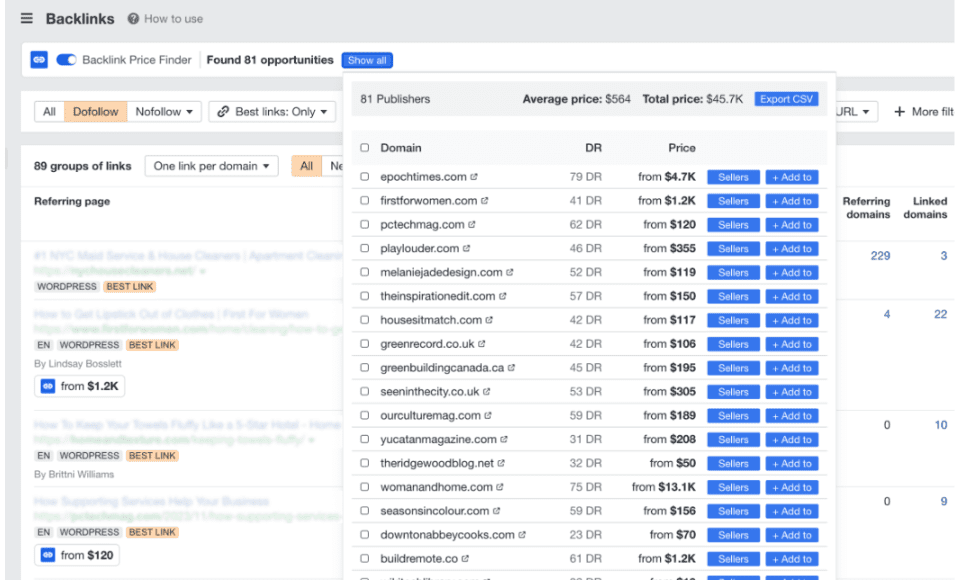Link Finder Review: Save Time and Money on Link Building in 2025 I’ve spent thousands of dollars on backlinks over the years, both for my own sites and client projects. And let me tell you – there’s nothing more frustrating than discovering you’ve massively overpaid for a link that could have been purchased elsewhere for […]
Link Finder Review: Save Time and Money on Link Building in 2025
I’ve spent thousands of dollars on backlinks over the years, both for my own sites and client projects. And let me tell you – there’s nothing more frustrating than discovering you’ve massively overpaid for a link that could have been purchased elsewhere for half the price.
It’s a common problem in our industry. You find what seems like a decent link opportunity, pay $300 for it, then later discover the exact same placement was available on another marketplace for $150. Meanwhile, you’ve wasted hours hopping between different platforms trying to compare prices and find the best deals.
That’s where Link Finder comes in. This link marketplace comparison tool is revolutionizing how SEOs approach link buying by bringing transparency to a historically opaque market.
Think of it as the Skyscanner of link building – a platform that aggregates prices from over 50 different link marketplaces and lets you instantly compare costs across more than 300,000 websites. No more manual price checking across multiple platforms or overpaying for links that could be had cheaper elsewhere.

I’ve been using Link Finder for the past few months to manage link-building campaigns for both my agency clients and personal projects. In this review, I’ll share my hands-on experience with the platform, including what I love, what could be better, and whether it’s worth the investment for different types of users.
You can sign up for Link Finder here and get one free search to test its capabilities.
First Impressions: Clean Interface, Clear Value Proposition
When I first logged into Link Finder, I was immediately struck by how intuitive the interface is. As someone who’s tested dozens of SEO tools over the years, I’ve developed a pretty low tolerance for clunky UIs that require watching tutorial videos just to get started.
Thankfully, Link Finder gets right to the point. The main dashboard is clean and focused, with the primary search bar prominently displayed. You can search by domain, keyword, or upload a bulk list of URLs to check. The platform pulls data from major link marketplaces like EReferrer, Linkbroker, PRNews.io, and WhitePress, among others.
Setting up my account took less than 5 minutes, and I was able to start my first search without any hand-holding. The Chrome extension installation was equally painless – a one-click process that adds Link Finder’s price comparison functionality directly to your browser.
The speed of Link Finder was also a big win for me. Unlike some competitor tools that can take 30+ seconds to load results, Link Finder returns price comparisons almost instantly. When you’re processing hundreds of potential link opportunities, this kind of performance makes a real difference in workflow efficiency.
One minor learning curve I encountered was understanding the LinkFinder Score (LS) – their proprietary metric for evaluating link opportunities. While the documentation explains it well, it took me a few searches to internalize how to best use this metric in conjunction with other data points. That said, it’s become one of my favorite features now that I’m comfortable with it.
Key Features: Much More Than Just Price Comparison
While Link Finder’s core functionality is finding the best prices for link placements, the platform offers several features that make it a comprehensive link building tool. Let’s dive into the ones I’ve found most valuable in my day-to-day work:
AI-Powered Search
The feature I probably use most is Link Finder’s AI search capability. Instead of just searching by domain or keyword, it takes your website URL and combines all its different search tools into one AI process. Then it identifies the best opportunities for your site based on competitor analysis and keyword opportunities.
You get a curated list of sites with their lowest available prices across all marketplaces. Each suggestion comes with a custom LinkFinder Score (LS) that helps evaluate the opportunity.
Competitor Backlink Analysis
This is where Link Finder really shines compared to traditional backlink analysis tools. Not only does it show you where your competitors are getting links from, but it also tells you if those exact placements are available for purchase and at what price.
I recently used this feature to analyze a competitor who had shot up in rankings for a valuable keyword. Within minutes, I identified three high-quality links they’d acquired – and found them at the best price through Link Finder.

Bulk Domain Processing
For agency owners like myself, the bulk processing feature is a massive time saver. You can upload up to 3,000 domains at once (on the highest plan) and get comprehensive pricing data across all supported marketplaces. The export function lets you easily share pricing data with clients or team members.
A neat trick I discovered: You can also use this feature to quickly price-check lists of referring domains exported from tools like Ahrefs or Semrush. This is particularly useful when replicating competitor backlink profiles or planning large-scale campaigns.
Chrome Extension Integration
The Chrome extension is particularly clever in its implementation. When you’re browsing Google search results, it automatically highlights websites where you can purchase links and shows the lowest available price. This is incredibly useful for finding natural link opportunities within your niche.
I especially appreciate how it integrates with Google Search Console and popular SEO tools. When reviewing backlink data in Ahrefs, for instance, you can instantly check if any of the referring domains sell links and compare prices across marketplaces.
The platform’s SERP scanner provides similar functionality – just enter a search term and you’ll get a list of backlinks that

Project Management & Monitoring
One feature that doesn’t get enough attention is Link Finder’s project management system. You can organize link opportunities into different campaigns, track prices over time, and get notified when prices drop below a certain threshold.
Pricing and Plans: Is Link Finder Worth the Investment?
Let’s talk money. Link Finder offers three pricing tiers, and I’ll break down who each one is best suited for based on my experience:
Standard Plan ($39/month)
- 300 results per search
- 3 AI searches per month
- 50 keyword searches
- 20 competitive analyses
- 200 Chrome extension clicks
This entry-level plan is perfect for individual site owners or freelance SEOs who manage a small portfolio of sites. I started with this plan when testing the platform, and it was more than sufficient for managing link building for 2-3 websites.
Booster Plan ($89/month)
- 1,000 results per search
- 20 AI searches
- 250 keyword searches
- 100 competitive analyses
- 1,000 Chrome extension clicks
This is the sweet spot for small agencies or serious affiliate site builders. I currently use this plan to manage link building for my agency’s clients, and the increased limits provide good value for the price jump.
Spammer Plan ($150/month)
- 30,000 results per search
- 70 AI searches
- 2,000 keyword searches
- 500 competitive analyses
- 5,000 Chrome extension clicks

Despite the cheeky name, this plan is serious business. It’s designed for larger agencies and enterprises handling multiple high-volume campaigns. The unlimited-feeling search limits mean you’ll never hit a ceiling during research.
You can save up to 68% on these plans if you pay annually, too. My preference when trying a new SEO tool is to begin with a monthly plan and then commit to an annual plan when I’m confident it’s the right fit.
ROI Analysis: Real Numbers from Real Campaigns
Here’s where I get specific about value. In my first month using Link Finder, I saved an average of $147 per link across 12 link purchases simply by finding the same placements at lower prices on different marketplaces. That’s $1,764 in savings from a $39 investment.
Let’s break down a typical scenario:
- Average link cost without Link Finder: $350
- Same link found through Link Finder: $245
- Average savings per link: $105
- Links needed to break even on Standard plan: 0.37 links
Even if you’re only buying 2-3 links per month, the tool pays for itself through price savings alone. Factor in the time saved from not having to manually check multiple marketplaces, and the ROI becomes even more compelling.
When I say that Link Finder could save you tens of thousands of dollars on a single link, I’m not exaggerating. Just look at the numbers in this screenshot to see what big price variations there are between marketplaces:

Pros and Cons: The Good, The Bad, and The Reality
After using Link Finder extensively for several months, here’s my honest assessment of where it shines and where it could use improvement:
The Good
Massive Time Savings I estimate Link Finder saves me about 4-5 hours per week that I used to spend manually checking prices across different marketplaces. For agency owners, this time savings alone justifies the subscription cost.
Genuine Price Advantages The tool consistently finds better deals than manual searching. In my experience, you can expect to save 20-30% on average per link just by finding the same placement at a better price.
Excellent Chrome Extension The browser extension is thoughtfully designed and actually useful – not just a tacked-on feature. Being able to see link prices while browsing Google search results is a game-changer for opportunity research.
Regular Database Updates The marketplace database is updated monthly, ensuring you’re working with current pricing data. This is crucial in an industry where prices can fluctuate significantly.
Intuitive Interface You can be up and running in minutes without watching tutorial videos or reading documentation. The learning curve is minimal for core features.
The Not-So-Good
Limited Free Trial: While you get one free search to test the tool, a proper 7-day trial would make it easier to evaluate the full feature set before committing.
AI Search Credit Limits: The AI search feature is fantastic but the credit limits (especially on the Standard plan) feel a bit restrictive. Three searches per month isn’t much if you’re actively prospecting.
Basic Reporting Features: The reporting functionality could be more robust, especially for agencies needing to create client-facing reports. You’ll likely need to export data and create your own report templates.
Limited Filtering: If you’re used to marketplaces like PressWhizz and WhitePress that let you apply a whole range of filters to narrow down your search, you may find Link Finder lacking in this area.
Marketplace Coverage Gaps: While Link Finder covers most major link marketplaces, there are still some smaller ones that aren’t included in the database. However, they’re continuously adding new sources.
Alternative Options: How Does Link Finder Stack Up?
Let’s look at how Link Finder compares to some popular alternatives in the market:
Link Finder vs. Backlink Price Finder (Chrome Extension)
Price Comparison:
- Link Finder: From $39/month + cost per link
- Backlink Price Finder: $12.50/month (billed annually at $150) + cost per link
At first glance, Backlink Price Finder’s Chrome extension might seem like the better deal due to its lower price point. It offers similar core functionality – showing you link prices while browsing websites – and claims to have a database of over 400,000 websites that provide paid placements.
Where Backlink Price Finder shines:
- More affordable for individual users
- Simpler learning curve
- Works directly in search results and popular SEO tools
- No monthly usage limits
However, in my testing, Link Finder offers several significant advantages:
- Is a standalone tool with more features
- More accurate pricing data (updated monthly vs. quarterly)
- Covers more marketplaces (50 vs. 30)
- Includes AI-powered search capabilities
- Offers bulk domain checking
- Provides competitive analysis tools
Best For: Backlink Price Finder is ideal for individual site owners or bloggers who primarily need basic price checking functionality and don’t require advanced features like AI search or competitor analysis.

Link Finder vs. PressWhizz
PressWhizz takes a different approach as a direct link marketplace rather than a comparison tool. With over 37,000 curated websites across 20+ countries, it’s certainly not the largest direct-to-publisher platform, but it does have the strongest focus on quality and service.
Price Comparison:
- Link Finder: From $39/month + cost per link
- PressWhizz: Free to access marketplace (pay per link)
You might choose to go directly to PressWhizz if you want the assurance of their 12-month placement guarantee or their stringent vetting process. It’s also a good choice if you’ll be purchasing less than one link a month and paying for a subscription doesn’t make sense.
Where PressWhizz excels:
- Direct relationships with publishers
- Guaranteed 12-month link placements
- Quality assurance on all listings
- No monthly subscription required
- Comprehensive publisher metrics
But there are tradeoffs:
- Fixed prices for links
- Limited to their own network
- No price comparison functionality
Here’s a real example: I recently found a tech blog link on PressWhizz for $350. Using Link Finder, I discovered the same placement was available through another marketplace for $315 – but without the 12-month guarantee. I decided it was worth paying the extra $35 to avoid the potential headache of the link disappearing a couple of months down the line.
Best For: PressWhizz is ideal for businesses prioritizing link placement guarantees and quality assurance. It’s particularly good for enterprise or agency clients who need reliable, long-term placements.
Comparison Table: Key Features
| Feature |
Link Finder |
Backlink Price Finder |
PressWhizz |
| Best For |
Agencies & serious SEOs |
Individual site owners |
Enterprises, agencies & quality-focused buyers |
| Standout Feature |
AI-powered search & bulk analysis |
Simple browser integration |
12-month link guarantees |
| Price Range |
$39-150/month |
$12.50/month |
Free (pay per link) |
| Database Size |
300,000+ sites |
400,000+ sites |
37,000+ sites |
| Link Guarantees |
Varies by marketplace |
Varies by marketplace |
12 months |
The choice between these tools ultimately depends on your specific needs. I actually use both Link Finder and PressWhizz for my own projects – Link Finder for research and price comparison, and PressWhizz when clients specifically request guaranteed placements with longer commitments.
Who Should Use Link Finder?
After spending considerable time with the platform, I’ve identified the types of users who will get the most value from Link Finder:
SEO Agencies
If you’re running an agency, Link Finder is practically a no-brainer. The bulk search capabilities and competitive analysis features alone can save hours of work per client. I’ve found it particularly valuable for:
- Quickly pricing out link-building campaigns for client proposals
- Finding the best deals across multiple marketplaces
- Tracking competitor link acquisition strategies
- Managing multiple link-building campaigns simultaneously
Affiliate Site Builders
For those building and scaling affiliate sites, Link Finder’s ability to find the best prices on relevant links can significantly improve ROI. The AI search feature is especially useful for finding topically relevant placements within your niche.
In-House SEO Teams
Enterprise SEO teams managing large-scale link-building campaigns can benefit from:
- Bulk domain processing for efficient research
- Project management features for tracking campaigns
- Price monitoring for budget optimization
- Competitive analysis tools for market research
Who Might Want to Skip It
Link Finder might not be the best investment if you:
- Only build links occasionally (less than 1-2 per month)
- Exclusively use white-hat outreach for link-building
- Already have direct relationships with publishers
- Are just starting out and have a very limited budget
The Bottom Line: Real Results for Real SEOs
After three months of using Link Finder for my agency’s link-building campaigns, here’s what the numbers look like:
- Average time saved per week: 4.5 hours
- Average cost savings per link: $105
- Total links purchased: 47
- Total savings: $4,935
- ROI: 1,850% (based on Booster plan subscription)
But perhaps more importantly, Link Finder has fundamentally changed how we approach link building. Instead of accepting the first decent price we find, we now have confidence that we’re getting the best possible deals across all major marketplaces.
The platform isn’t perfect – the AI search limits could be more generous, and the reporting features could use some work. But for anyone seriously involved in link building, it’s become an indispensable tool that pays for itself many times over.
Would I recommend it? Absolutely. Just be sure to choose the right plan for your needs:
- Standard ($39/month) for individual site owners and freelancers
- Booster ($89/month) for small agencies and serious affiliate marketers
- Spammer ($150/month) for larger agencies and enterprise teams
FAQs
How accurate is Link Finder’s pricing data?
Link Finder updates its database monthly, and in my experience, the pricing data is highly accurate. I’ve verified hundreds of prices manually and found very few discrepancies. When differences do occur, they’re usually due to recent price changes that haven’t yet been captured in the monthly update.
Can Link Finder help negotiate better prices?
While Link Finder doesn’t negotiate prices directly, having access to comprehensive pricing data gives you leverage in negotiations. I’ve successfully used price comparisons from Link Finder to get better deals on several occasions, especially when dealing directly with publishers.
Does Link Finder offer refunds?
Yes, Link Finder offers a 14-day money-back guarantee on your subscription fee if you’re not satisfied with the service. They also provide one free search before you need to commit to a subscription, allowing you to test the basic functionality.
How does Link Finder compare to manual marketplace research?
Based on my testing, using Link Finder is approximately 5-6 times faster than manually checking multiple marketplaces. For a typical list of 100 domains, what would take 3-4 hours manually can be done in about 30 minutes with Link Finder, with the added benefit of finding better prices.